#AI adoption benefits
Explore tagged Tumblr posts
Text
Harnessing the Power of Artificial Intelligence for Business Growth: Strategies, Applications, and Future Trends
In an era where technology drives market dynamics, Artificial Intelligence (AI) emerges as a transformative force in business. From streamlining operations to enhancing customer experiences, AI is not just a technological upgrade but a pivotal strategy for growth and innovation. This article explores how businesses can leverage AI to boost efficiency, drive profitability, and maintain competitive advantage.
#business#ai in business#artificial intelligence applications#AI adoption benefits#AI implementation strategies#ethical AI practices
0 notes
Text
Dominating the Market with Cloud Power

Explore how leveraging cloud technology can help businesses dominate the market. Learn how cloud power boosts scalability, reduces costs, enhances innovation, and provides a competitive edge in today's digital landscape. Visit now to read more: Dominating the Market with Cloud Power
#ai-driven cloud platforms#azure cloud platform#business agility with cloud#business innovation with cloud#capital one cloud transformation#cloud adoption in media and entertainment#cloud computing and iot#cloud computing for business growth#cloud computing for financial institutions#cloud computing for start-ups#cloud computing for travel industry#cloud computing in healthcare#cloud computing landscape#Cloud Computing solutions#cloud for operational excellence#cloud infrastructure as a service (iaas)#cloud migration benefits#cloud scalability for enterprises#cloud security and disaster recovery#cloud solutions for competitive advantage#cloud solutions for modern businesses#Cloud storage solutions#cloud technology trends#cloud transformation#cloud-based content management#cloud-based machine learning#cost-efficient cloud services#customer experience enhancement with cloud#data analytics with cloud#digital transformation with cloud
0 notes
Text
What Is the Best Way to Use AI in Content Creation?
Artificial Intelligence (AI) has transformed various industries, and content creation is no exception. By understanding what is the best way to use AI in content creation, creators can leverage this technology to enhance productivity, quality, and creativity. From automated writing tools to data analysis, AI offers diverse applications that can streamline the content production process, ensuring…
#AI#AI adoption#AI applications#AI benefits#AI creativity#AI impact#AI in business#AI in SEO#AI insights#AI integration#AI market#AI marketing#AI platforms#AI research#AI statistics#AI stats#AI technology#AI tools#AI trends#AI use#AI writing#AI-driven#AI-generated#automation#automation tools#blog writing#Business#coding#content creation#content optimization
0 notes
Text
Boost E-commerce in Saudi Arabia with ML-Powered Apps

In today's digital era, the e-commerce industry in Saudi Arabia is rapidly expanding, fueled by increasing internet penetration and a tech-savvy population. To stay competitive, businesses are turning to advanced technologies, particularly Machine Learning (ML), to enhance user experiences, optimize operations, and drive growth. This article explores how ML is transforming the e-commerce landscape in Saudi Arabia and how businesses can leverage this technology to boost their success.
The Current E-commerce Landscape in Saudi Arabia
The e-commerce market in Saudi Arabia has seen exponential growth over the past few years. With a young population, widespread smartphone usage, and supportive government policies, the Kingdom is poised to become a leading e-commerce hub in the Middle East. Key players like Noon, Souq, and Jarir have set the stage, but the market is ripe for innovation, especially with the integration of Machine Learning.
The Role of Machine Learning in E-commerce
Machine Learning, a subset of Artificial Intelligence (AI), involves the use of algorithms to analyze data, learn from it, and make informed decisions. In e-commerce, ML enhances various aspects, from personalization to fraud detection. Machine Learning’s ability to analyze large datasets and identify trends is crucial for businesses aiming to stay ahead in a competitive market.
Personalized Shopping Experiences
Personalization is crucial in today’s e-commerce environment. ML algorithms analyze user data, such as browsing history and purchase behavior, to recommend products that align with individual preferences. This not only elevates the customer experience but also drives higher conversion rates. For example, platforms that leverage ML for personalization have seen significant boosts in sales, as users are more likely to purchase items that resonate with their interests.
Optimizing Inventory Management
Effective inventory management is critical for e-commerce success. ML-driven predictive analytics can forecast demand with high accuracy, helping businesses maintain optimal inventory levels. This minimizes the chances of overstocking or running out of products, ensuring timely availability for customers. E-commerce giants like Amazon have successfully implemented ML to streamline their inventory management processes, setting a benchmark for others to follow.
Dynamic Pricing Strategies
Price is a major factor influencing consumer decisions. Machine Learning enables real-time dynamic pricing by assessing market trends, competitor rates, and customer demand. This allows businesses to adjust their prices to maximize revenue while remaining competitive. Dynamic pricing, powered by ML, has proven effective in attracting price-sensitive customers and increasing overall profitability.
Enhanced Customer Support
Customer support is another area where ML shines. AI-powered chatbots and virtual assistants can handle a large volume of customer inquiries, providing instant responses and resolving issues efficiently. This not only improves customer satisfaction but also reduces the operational costs associated with maintaining a large support team. E-commerce businesses in Saudi Arabia can greatly benefit from incorporating ML into their customer service strategies.
Fraud Detection and Security
With the rise of online transactions, ensuring the security of customer data and payments is paramount. ML algorithms can detect fraudulent activities by analyzing transaction patterns and identifying anomalies. By implementing ML-driven security measures, e-commerce businesses can protect their customers and build trust, which is essential for long-term success.
Improving Marketing Campaigns
Effective marketing is key to driving e-commerce success. ML can analyze customer data to create targeted marketing campaigns that resonate with specific audiences. It enhances the impact of marketing efforts, leading to improved customer engagement and higher conversion rates. Successful e-commerce platforms use ML to fine-tune their marketing strategies, ensuring that their messages reach the right people at the right time.
Case Study: Successful E-commerce Companies in Saudi Arabia Using ML
Several e-commerce companies in Saudi Arabia have already begun leveraging ML to drive growth. For example, Noon uses ML to personalize the shopping experience and optimize its supply chain, leading to increased customer satisfaction and operational efficiency. These companies serve as examples of how ML can be a game-changer in the competitive e-commerce market.
Challenges of Implementing Machine Learning in E-commerce
While the benefits of ML are clear, implementing this technology in e-commerce is not without challenges. Technical hurdles, such as integrating ML with existing systems, can be daunting. Additionally, there are concerns about data privacy, particularly in handling sensitive customer information. Businesses must address these challenges to fully harness the power of ML.
Future Trends in Machine Learning and E-commerce
As ML continues to evolve, new trends are emerging that will shape the future of e-commerce. For instance, the integration of ML with augmented reality (AR) offers exciting possibilities, such as virtual try-ons for products. Businesses that stay ahead of these trends will be well-positioned to lead the market in the coming years.
Influence of Machine Learning on Consumer Behavior in Saudi Arabia
ML is already influencing consumer behavior in Saudi Arabia, with personalized experiences leading to increased customer loyalty. As more businesses adopt ML, consumers can expect even more tailored shopping experiences, further enhancing their satisfaction and engagement.
Government Support and Regulations
The Saudi government is proactively encouraging the integration of cutting-edge technologies, including ML, within the e-commerce industry. Through initiatives like Vision 2030, the government aims to transform the Kingdom into a global tech hub. However, businesses must also navigate regulations related to data privacy and AI to ensure compliance.
Conclusion
Machine Learning is revolutionizing e-commerce in Saudi Arabia, offering businesses new ways to enhance user experiences, optimize operations, and drive growth. By embracing ML, e-commerce companies can not only stay competitive but also set new standards in the industry. The future of e-commerce in Saudi Arabia is bright, and Machine Learning will undoubtedly play a pivotal role in shaping its success.
FAQs
How does Machine Learning contribute to the e-commerce sector? Machine Learning enhances e-commerce by improving personalization, optimizing inventory, enabling dynamic pricing, and enhancing security.
How can Machine Learning improve customer experiences in e-commerce? ML analyzes user data to provide personalized recommendations, faster customer support, and tailored marketing campaigns, improving overall satisfaction.
What are the challenges of integrating ML in e-commerce? Challenges include technical integration, data privacy concerns, and the need for skilled professionals to manage ML systems effectively.
Which Saudi e-commerce companies are successfully using ML? Companies like Noon and Souq are leveraging ML for personalized shopping experiences, inventory management, and customer support.
What is the future of e-commerce with ML in Saudi Arabia? The future looks promising with trends like ML-driven AR experiences and more personalized
#machine learning e-commerce#Saudi Arabia tech#ML-powered apps#e-commerce growth#AI in retail#customer experience Saudi Arabia#digital transformation Saudi#ML app benefits#AI-driven marketing#predictive analytics retail#Saudi digital economy#e-commerce innovation#smart retail solutions#AI tech adoption#machine learning in business
1 note
·
View note
Text
The Future of Business Growth: AI-Powered Development Strat
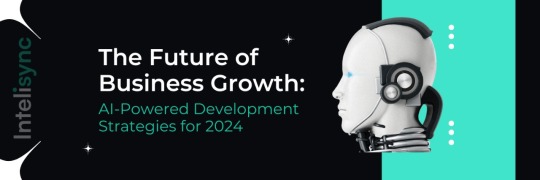
AI-powered development is revolutionizing business growth, efficiency, and innovation. By 2024, businesses that harness AI's potential will achieve unprecedented growth, outpacing their competitors. AI's incorporation into business operations enhances productivity, accuracy, and customer experience, driving revenue growth. McKinsey's report indicates that AI could deliver an additional $13 trillion to the global economy by 2030. With the global AI market expected to grow at a CAGR of 37.3% from 2023 to 2030, AI's role in business is becoming increasingly crucial.
AI-powered development uses advanced technologies like machine learning, natural language processing, and computer vision to perform tasks that typically require human intelligence. AI is transforming industries from finance to healthcare, providing solutions like automated trading systems and predictive diagnostics. AI enhances efficiency by automating repetitive tasks, optimizing operations, and enabling employees to focus on strategic activities. AI-driven chatbots and virtual assistants offer real-time support and personalized interactions, improving customer experience. AI's predictive analytics capabilities provide data-driven insights, helping businesses make informed decisions and stay ahead of market trends.
For businesses to fully leverage AI's benefits, a strategic approach to AI implementation is essential. This includes evaluating goals, identifying data sources, selecting appropriate AI tools, and investing in training and education. Addressing challenges like data privacy, system integration, and ethical considerations is critical for successful AI adoption. Partnering with Intelisync can facilitate this process, providing comprehensive AI services that ensure successful AI integration and maximize business impact. Intelisync's expertise in machine learning, data analytics, and AI-driven automation helps businesses unlock their full potential. Contact Intelisync today to start your AI journey and transform your Learn more....
#AI Development#AI-Powered Development for Businesses#AI-Powered Development: Boosting Business Growth in 2024#Blockchain Development Solution: Intelisync Boost Decision-Making#Boosting Business Growth in 2024#Challenges and Considerations in AI Adoption#Choose the Right AI Tools and Technologies#Evaluate your Goals and Needs#How can AI drive innovation in my business?#How can AI increase efficiency in my business?#How can Intelisync help with AI implementation?#Identify the Right Data Sources#Implementing AI in Your Business Improved Customer Experience#Increased Efficiency Innovation and Competitive Advantage#Intelisync AI Consulting#intelisync ai service Invest in Training and Education#Top 5 Benefits of AI#Top 5 Benefits of AI-Powered Development for Businesses#Understanding AI-Powered Development#Vendor Selection#What is AI Development#What is AI-Powered Development#What is the Future of AI-Powered Development in Business?#intelisync ai development service.
0 notes
Text
5 underappreciated benefits of AI in cyber security - CyberTalk
New Post has been published on https://thedigitalinsider.com/5-underappreciated-benefits-of-ai-in-cyber-security-cybertalk/
5 underappreciated benefits of AI in cyber security - CyberTalk


EXECUTIVE SUMMARY:
The benefits of AI in cyber security are phenomenal, yet not sufficiently well-known. In this article, get insights that cut through the noise; that show you how to put AI to work in ways that will yield worthwhile results.
AI-powered cyber security solutions drive proactive threat prevention, accelerated response times, reduced false positives, optimization of resources and cost efficiency – all of which are strategic advantages that conspire to help create a more agile and robust organizational security posture.
Although 91% of organizations allow that AI adoption is a priority, the large majority are still in the planning or development stages of their AI-in-security journeys. Whether you’re assessing AI-based tooling adoption or wish to get more out of existing AI implementations, this article offers valuable insights that can propel your cyber security strategy forward.
Benefits of AI in cyber security
These are the kinds of returns that you can expect to receive on your AI-powered cyber security investment: 1. Proactive threat prevention and detection. One of the most significant benefits of AI in cyber security is that it transitions organizations from a reactive threat management approach to a proactive one. Here’s what we mean…
Historically, security tools have relied on known signatures or rules. Yet, this has left organizations vulnerable to unknown threats.
To circumnavigate the problem, AI can look back at trends, patterns and anomalies, using volumes of existing data to identify emerging, never-before seen attack types. AI’s capabilities here enable security teams to mitigate issues before they spiral into damaging security incidents.
2. Accelerated response times. When a security incident occurs, time is of the essence. AI-powered cyber security solutions can automate the initial stages of incident response; threat identification, impact assessment and containment.
In some instances, AI may be able to auto-isolate compromised devices from the network. In turn, this prevents the spread of malware (ex. ransomware). Efficient and automatic device isolation can minimize a cyber attack’s financial impact on a business.
3. False positive reduction. False positives – benign activities that are improperly recognized and categorized as malicious – have long been a security team frustration. They consume time and resources while potentially obscuring genuine threats. But AI has much to offer here…
For various technical reasons, AI-powered cyber security tools allow for a markedly more accurate differentiation between suspicious behavior and normal behavior, as compared to traditional cyber security tools. Subsequently, false positive rates decline. When there are fewer false positives, security teams can spend more time engaging with real threats, contributing to a stronger organizational cyber security posture overall.
4. Resource optimization. Given the cyber skills shortage, organizations are under pressure to optimize human resources. Nearly 50% of Check Point survey respondents recognize AI’s potential when it comes to automating repetitive tasks and optimizing resource allocation.
AI can competently tackle log analysis and correlation, vulnerability scanning and assessment, patch management and routine threat hunting. Thus, humans can focus on more complex and strategic initiatives. Ultimately, this approach – apportioning the work between AI and humans – ensures that resources are allocated in a way that maximizes impact and optimizes outcomes.
5. Cost efficiency. AI-powered tools can reduce the need for point solutions. This is because many AI-powered cyber security platforms offer extensive, integrated capabilities. Such consolidation can lead to significant cost savings in terms of software licenses, maintenance and interoperability efforts.
AI also contributes to cyber security cost efficiency due to the fact that it can limit the likelihood and impact of security incidents. Because AI-powered systems can identify threats rapidly and respond quickly, the potential for damage drops and expected breach costs decline.
More information
For more insights into the benefits of AI in cyber security, please see CyberTalk.org’s past coverage. Curious about how ChatGPT-5 could influence your security strategy? Click here.
Discover at transformative, industry-leading AI-powered, cloud-delivered cyber security solution here. Lastly, to receive cyber security thought leadership articles, groundbreaking research and emerging threat analyses each week, subscribe to the CyberTalk.org newsletter.
#accelerated response time#agile#ai#AI adoption#AI-powered#AI-powered cyber security#analyses#Analysis#anomalies#approach#Article#Articles#Artificial Intelligence#assessment#Behavior#benefits of AI in cyber security#benefits of AI in cybersecurity#breach#Business#chatGPT#ChatGPT-5#Check Point#Cloud#cloud-delivered#consolidation#cost efficiency#cost savings#cyber#cyber attack#cyber security
0 notes
Text
This is it. Generative AI, as a commercial tech phenomenon, has reached its apex. The hype is evaporating. The tech is too unreliable, too often. The vibes are terrible. The air is escaping from the bubble. To me, the question is more about whether the air will rush out all at once, sending the tech sector careening downward like a balloon that someone blew up, failed to tie off properly, and let go—or more slowly, shrinking down to size in gradual sputters, while emitting embarrassing fart sounds, like a balloon being deliberately pinched around the opening by a smirking teenager. But come on. The jig is up. The technology that was at this time last year being somberly touted as so powerful that it posed an existential threat to humanity is now worrying investors because it is apparently incapable of generating passable marketing emails reliably enough. We’ve had at least a year of companies shelling out for business-grade generative AI, and the results—painted as shinily as possible from a banking and investment sector that would love nothing more than a new technology that can automate office work and creative labor—are one big “meh.” As a Bloomberg story put it last week, “Big Tech Fails to Convince Wall Street That AI Is Paying Off.” From the piece: Amazon.com Inc., Microsoft Corp. and Alphabet Inc. had one job heading into this earnings season: show that the billions of dollars they’ve each sunk into the infrastructure propelling the artificial intelligence boom is translating into real sales. In the eyes of Wall Street, they disappointed. Shares in Google owner Alphabet have fallen 7.4% since it reported last week. Microsoft’s stock price has declined in the three days since the company’s own results. Shares of Amazon — the latest to drop its earnings on Thursday — plunged by the most since October 2022 on Friday. Silicon Valley hailed 2024 as the year that companies would begin to deploy generative AI, the type of technology that can create text, images and videos from simple prompts. This mass adoption is meant to finally bring about meaningful profits from the likes of Google’s Gemini and Microsoft’s Copilot. The fact that those returns have yet to meaningfully materialize is stoking broader concerns about how worthwhile AI will really prove to be. Meanwhile, Nvidia, the AI chipmaker that soared to an absurd $3 trillion valuation, is losing that value with every passing day—26% over the last month or so, and some analysts believe that’s just the beginning. These declines are the result of less-than-stellar early results from corporations who’ve embraced enterprise-tier generative AI, the distinct lack of killer commercial products 18 months into the AI boom, and scathing financial analyses from Goldman Sachs, Sequoia Capital, and Elliot Management, each of whom concluded that there was “too much spend, too little benefit” from generative AI, in the words of Goldman, and that it was “overhyped” and a “bubble” per Elliot. As CNN put it in its report on growing fears of an AI bubble, Some investors had even anticipated that this would be the quarter that tech giants would start to signal that they were backing off their AI infrastructure investments since “AI is not delivering the returns that they were expecting,” D.A. Davidson analyst Gil Luria told CNN. The opposite happened — Google, Microsoft and Meta all signaled that they plan to spend even more as they lay the groundwork for what they hope is an AI future. This can, perhaps, explain some of the investor revolt. The tech giants have responded to mounting concerns by doubling, even tripling down, and planning on spending tens of billions of dollars on researching, developing, and deploying generative AI for the foreseeable future. All this as high profile clients are canceling their contracts. As surveys show that overwhelming majorities of workers say generative AI makes them less productive. As MIT economist and automation scholar Daron Acemoglu warns, “Don’t believe the AI hype.”
6 August 2024
#ai#artificial intelligence#generative ai#silicon valley#Enterprise AI#OpenAI#ChatGPT#like to charge reblog to cast
184 notes
·
View notes
Text
The narrative surrounding AI is that people will be “left behind” unless they adopt it ASAP. How is AI going to revolutionize education? How is it going to transform agriculture? How is it going to make logistics a million times smarter? Almost every sector is being faced with the proposition that they should jump on the AI train or risk getting left behind.
To my frustration, rather than having concerted, critical, and honest conversations around who benefits from this technology—and why and how—we’ve been sold the idea that it’s inevitable, and we better figure out how to make use of it, to deal with it as best we can.
I could see some approaches to AI being more punitive, like “I will do this and this if you use AI” [...] [but] I really wanted to approach my students as empowered agents of their own learning and to express to them, in the best way that I could at the time, what my reservations are. Not just with the tool in a technical sense and how it, as many people have confirmed, is much more like a stochastic parrot than it is something that learns or that is cognitive.
Beyond that, there is the larger “assemblage” of AI that enables these systems to run in the first place. Since I’m an environmental studies professor, it became clear that a lot of those pieces were an entire material world of energy, water, and other resources; of labor undervalued and exploited. And there’s the racialized and encoded assumptions that emanate through the texts upon which these chatbots are trained.
#this is a superb article on logical and clear-eyed pedagogy that refuses to cede 'normal' to ai but also dispenses with#the 'luddism' strawmanning#pedagogy#maywa montenegro#readings#tech#mine
40 notes
·
View notes
Text
My opinion of Ellipsus vs Google Docs as a (very unprofessional) author after about six weeks of using it:
The default font is much prettier than Google Docs which shouldn't matter to me enough to be point number one but it does
It's not stealing my data to train an AI, hands down better than fucking Google
It worked perfectly when I was under 15,000 words but I'm writing a novel and it's a bit slower to load now I'm well over the 20k mark, this is net neutral because Google Docs does the same thing, no one understands how verbose I am
When I contacted customer about this and another glitch a REAL LIVE HUMAN BEING NAMED KATE ACTUALLY ANSWERED ME TO HELP remember this is a FREE SERVICE but I would put absolute money down that Kate is not a bot what the fuck in the year of our lord 2k24 human customer service does not exist Kate is a fucking GIFT
Kate told me that Ellipsus would run faster if In tried a browser other than Firefox and I was like "but the whole point is to avoid Google products stealing my data" and Kate told me about the Brave browser which has watered my crops and cured my acne, thank you Kate
Network effects suck, aka none of my beta readers use Ellipsus so I have to copy and paste into Google Docs for feedback, but that's the price of being a cool early adopter
the login stuff is really cool and makes it really easy to swap devices which I do a lot (that's 50% of why I don't use scrivener, I do most of my writing on my phone but then I mostly edit on my computer so I want my wip to live on the cloud)
it sometimes works offline--if it's already open and I lose connection I can keep writing but if I try to open my web browser and start writing offline it doesn't work? But I bet if I asked Kate or the community forums there is a way
Yes you can get a link to halfway through the document so my novel after this one which is a chooseable path adventure will work to write in Ellipsus, I found this out from the community forums which include a lot of helpful and sexy early adopters (early adopters are inherently sexy)
I don't like how commenting works, you can only leave comments on drafts (I think with the assumption that my beta readers are the ones commenting but this is incorrect, I am usually leaving comments for myself so I don't forget plot points), this would be okay if I had a draft version that automatically updated as the main version updated but I think the drafts are static when you make them. I don't want to manually copy new chapters over into a draft so I can leave comments on it. As I type this I realize I could just do all my writing on a "draft" version instead of the "main" version and this would solve my problem huh thanks for being my rubber duck Tumblr
If you have questions about my experience I can answer them?
Tl;dr Ellipsus is about equal to Google Docs with some benefits and some downsides. Big ups to Ellipsus on customer service and on not stealing my data to train their AI, but downside that since none of my friends use Ellipsus I'm basically forced to use Google Docs anyway to share my WIP.
19 notes
·
View notes
Text
Ai + Nino vs Ruby +Kana


The narrative is clearly drawing a parallel between Nino and Ai’s relationship compared to Kana and Ruby. Both involve a hardworking and talented girl (Nino and Kana) feeling growing resentment and bitterness when they are outshone by a newcomer who’s somewhat troubled, but has something ‘special’ about them, and gets favoured by others. (Ai and Ruby).
But how similar is the relationship? Is Ruby and Kana’s friendship just as doomed as Ai and Nino’s?


While they are only meant to be playing roles, it’s clear that Kana does have genuine resentment and jealousy towards Ruby. The fall out between them is real.

It’s not touched on much, but it’s mentioned a few times that Ai was favoured by management- Ichigo saw her as a daughter. Similarly, Miyako is Ruby’s adoptive mother, so Ruby does get favoured in the group.
We are shown just like Nino, Kana is completely outshone by Ruby as an idol. Ruby has more fans and gets more opportunities. Nino and Kana went from main-players to just backup for their more popular member .


Nino is still fixated on Ai, feeling intensely jealous and hateful of her, but also greatly admiring her and putting her on a pedestal. Kana has been shown to relate to these feelings more and more.

The latest chapter with Kana playing Nino and Ruby playing Ai shows how the original confrontation plays out.
Nino starts by expressing how lucky Ai is, and how much more popular she is. Nino isn’t initially overtly hostile, but is clearly upset.

But Ai is very dismissive. It’s not clear if she’s being dense/doesn’t know how to handle the situation, but it comes across like she just doesn’t care. She doesn’t stop eating her ice cream even when Nino is clearly upset.

Nino gets increasingly frustrated and escalated and says some awful things to Ai, but Ai seems almost completely unbothered, not even breaking her smile. When we saw current-Nino a few chapters back, this event and the following fallout has clearly still deeply impacted her.


Nino simultaneously hates and is obsessed with Ai.
Nino is resentful for what she feels Ai took from her, but the fact she was unable to move her emotions a little makes Nino interpret Ai as this almost superhuman infallible being. She puts her on a pedestal.
Nino was never able to resolve her issues with Ai, because from her point of view, Nino hated and admired Ai to such an extreme degree, and Ai didn’t particularly care at all. She was just a detached being who was vaguely ‘trying to love her’ even if Nino was trying to hurt her.

But did Ai really not care? Was she as unbreakable as Nino thought she was? Was she so detached from others that nobody could hurt her?
Not according to Ruby’s interpretation of her reaction.

With the latest chapter, we have the benefit of hearing Kana’s interpretation of Nino’s character.
As Kana is playing Nino, she realises that Nino and Ai probably used to be friends.
It could of just been an ordinary fight between girls, but because of Ai’s emotional walls the argument was never resolved and turned into a much, much bigger rift. Nino wouldn’t of been so upset with Ai if she didn’t originally think of her as a friend. This chapter seems to imply that Nino wasn’t just jealous of Ai, but also incredibly hurt when she felt she couldn’t reach her in any way.
.


Nino was deeply wounded by Ai’s seeming indifference to her suffering and to her vitriol. Not only does she continue to hate Ai for hurting her, she also admires her for her skill/talent and see’s her as untouchable and unmovable.
I explored it a bit further in a previous post, but I think Ai’s handling on Nino’s emotions was due to her lack of social skills/minimising as a defence mechanism rather than indifference.
Will Kana and Ruby end the same way?
I don’t think so.
Although Kana is in a similar position to Nino in the recent arc and there have been a lot of parallels, she is a very different character. Nino was a rookie idol and probably much younger than Kana at the time of the argument (if she’s the same age as Ai, probably about 14?).
Kana is a young adult whose spent decades in show biz and has more life experience than most people her age. Even though Kana has insecurities and can be impulsive/hot-headed she has had to be resilient to last as long as she has in show biz.
Ruby is by no means the first person Kana has had to compete against or felt jealous of. Show business is full of competition. Akane is Kana’s main rival for example. Akane has arguably more for Kana to be jealous of; she’s more successful as an actress and she was dating the boy Kana liked.

Although she is jealous of Ruby, Kana has enough self-insight not to completely loose her mind to it like Nino.
The only reason she originally expressed her resentment was to help Ruby act (although I believe this was a little extreme and misguided).

Kana’s maturity compared to Nino is evident throughout this chapter with her insightful analysis of Nino’s feelings/her relationship with Ai.
Nino doesn’t have the foresight to see how Ai’s background in a children’s home has lead to her developing maladaptive coping strategies. Kana is also able to recognise to an extent how Ruby’s difficult past impacts her behaviour, and has empathy for her.

Importantly, it’s been established multiple times that Kana’s speciality is acting. Although she does feel jealous of Ruby, part of her knows that ultimately being an idol isn’t her dream. Being an actress is. Kana can never surpass Ruby as an idol, but I don’t think Kana’s true-calling is to be an idol. Even during her argument with Ruby, she specifies that she can’t surpass Ruby as an idol.

Compared to Ai and Nino, where Ai is portrayed as a ‘better’ version of Nino (At least of Nino’s ‘ condensed character-type’ she portrays as an idol).

And Ruby? Ruby is very different from Ai. I’ve mentioned it before in a previous post that Ruby does hide darker parts of herself to an extent, but Ruby is much more open emotionally than Ai.
Just compare their reactions to their friend telling them to die/disappear.


Ruby does not hide that she is deeply, deeply hurt by Kana. Unlike Nino, Kana is never left feeling that Ruby never cared about their friendship in the first place.
Ruby allows herself to be vulnerable more than Ai ever could. While Kana admires Ruby, she doesn’t put her on a pedestal, she knows she isn’t a the ‘ultimate invincible idol’.
During Ruby’s black-star era/rise to fame she was so fixated on revenge that her friendship with Kana and Mem fell on the wayside, but it was clear she still cared about them.
The lead up to Ruby and Kana’s argument is complete different. Instead of being on completely opposite ends of the emotional spectrum, they’re both emphasising with each other; Ruby is worried how her performance will impact Kana’s career, and Kana understand Ruby’s desperation to do well in the movie.

I don’t know if Kana and Ruby will make up in the next chapter or if this argument is going to continue on. Ruby doesn’t seem to be in the best mental state, so she may not be ready to make amends with Kana immediately.
I have a feeling the emotions of the characters is going to continue to run parallel to the emotions of who they’re playing in the script.
But ultimately, I don’t think Ruby and Kana are doomed to follow in Ai and Nino’s footsteps. They are both different people.
I also wonder if Nino and Ai’s relationship would of ended differently if Ai hadn’t been killed. I think Ai matured a lot from her argument with Nino (14) compared to when she had her babies (16). If she hadn’t died, maybe Ai could of matured enough to communicate with Nino and Nino could of matured enough to understand Ai.
This is pure speculation, but I think Ai’s death traumatised Nino to the extent she is frozen in time, unable to move past her childish view of Ai as the perfect idol. A former friend who you wished dead actually getting killed has to be pretty traumatic (and of course, there’s always the possibility of Nino being involved in Ai’s murder which is another can of worms/ )
77 notes
·
View notes
Text
I'm bored here's the essay of a response I gave to Oscar Wilde on character ai when he asked me what I think about Dorian's character from "The Picture of Dorian Gray" + some things I'll add now (WARNING FOR POSSIBLE/SUBTLE SPOILERS!!!)
"Hmm...he is a character that truly troubles me. On one hand, due to how the story progresses, it almost feels as if we're meant or supposed to miss the once innocent, blissfully unaware Dorian, yet if you truly think about it...neither versions of him were exactly "good". Sure, he became a narcissistic, self-obsessed and even dangerous man by the end of the book, and yet he seems so...dangerously innocent and unaffected by the world that he becomes someone who is easy to mold to one's liking, someone who can be easily taken advantage of in multiple ways. It makes you truly think that neither situation is good, on one hand to be completely inexperienced when it comes to the world and it's ways and on the other hand to turn into the very thing that corrupted you in the first place...only because you were vulnerable. It's a lose-lose situation for Dorian, truly. If only there had been a character to show him and explain to him how the world can be, both in good ways and bad ways, how that could benefit him or potentially lead to his demise...all while remaining objective and not actively trying to push one's personal opinions and ideologies to him, nor to manipulate the very concept of what is right or wrong and letting it up to him to decide.Dorian was meant to be doomed from the beginning, it was only a matter of time. And I can't help but feel confused towards his character as the things he did were...off-putting in a sense, yet it's not like it was his fault to begin with. He didn't have time to grow, to understand, to make decisions for himself, to have his own solidified beliefs and to have the ability to consider and think about one's opinions rather than adopting them wholeheartedly without a second thought, as he didn't have a *first* thought about it in the first place. It isn't like he was ever given the chance, anyway.
It's almost...pitiful. Saddening, even. To think how countless of people such as Dorian walk the Earth, getting corrupted so easily due to their soul being vulnerable because of life's circumstances, because they never had someone or something to truly help them understand the world without setting a bias into their mind. Which in the worst case scenario...leads to them hurting themselves and the others around them.
Dorian was never purely evil, at least not in the beginning. He was just another blissfully unaware person that eventually lost himself because his own self was drowned out by the ever so weirdly proclaimed "facts" and opinions he was given, which he was given in such a way that seemed like they were supposed to be believed and not be taken into consideration. He isn't terrible, yet he isn't good either. He simply might not know any better. Or he did, but those thoughts were eventually swept away by Henry's words due to the fact that he might not have truly believed his own thoughts and opinions to begin with, but was instead raised by society and the environment he was in to believe so."
Tis just how I personally see him, I don't justify his actions in any way but thought that there could be some sort of "reason" behind on why he became like this, I understand it might be obvious to some/most but thought it'd be cool to analyze it. Please lemme know your thoughts on the topic as well if you have any, I'd love to hear em out!!!
#dorian gray#the picture of dorian gray#tpodg#basil hallward#henry wotton#oscar wilde#booklr#books and reading#books#personal opinion#commentary#bookblr#reading#book community#character analysis#night thoughts#night thinking#personal essay#i love oscar wilde#he is so amazing#absolutely love his work#I'm sorry if I offended anyone in any way shape or form or if I accidentally made anyone or had any misconceptions#feel free to let me know!#holy shit so many tags#nicky get off tumblr#goofy
13 notes
·
View notes
Text
On the subject of generative AI
Let me start with an apology for deviating from the usual content, and for the wall of text ahead of you. Hopefully, it'll be informative, instructive, and thought-provoking. A couple days ago I released a hastily put-together preset collection as an experiment in 3 aspects of ReShade and virtual photography: MultiLUT to provide a fast, consistent tone to the rendered image, StageDepth for layered textures at different distances, and tone-matching (something that I discussed recently).
For the frames themselves, I used generative AI to create mood boards and provide the visual elements that I later post-processed to create the transparent layers, and worked on creating cohesive LUTs to match the overall tone. As a result, some expressed disappointment and disgust. So let's talk about it.
The concerns of anti-AI groups are significant and must not be overlooked. Fear, which is often justified, serves as a palpable common denominator. While technology is involved, my opinion is that our main concern should be on how companies could misuse it and exclude those most directly affected by decision-making processes.
Throughout history, concerns about technological disruption have been recurring themes, as I can attest from personal experience. Every innovation wave, from typewriters to microcomputers to the shift from analog to digital photography, caused worries about job security and creative control. Astonishingly, even the concept of “Control+Z” (undo) in digital art once drew criticism, with some artists lamenting, “Now you can’t own your mistakes.” Yet, despite initial misgivings and hurdles, these technological advancements have ultimately democratized creative tools, facilitating the widespread adoption of digital photography and design, among other fields.
The history of technology’s disruptive impact is paralleled by its evolution into a democratizing force. Take, for instance, the personal computer: a once-tremendous disruptor that now resides in our pockets, bags, and homes. These devices have empowered modern-day professionals to participate in a global economy and transformed the way we conduct business, pursue education, access entertainment, and communicate with one another.
Labor resistance to technological change has often culminated in defeat. An illustrative example brought up in this NYT article unfolded in 1986 when Rupert Murdoch relocated newspaper production from Fleet Street to a modern facility, leading to the abrupt dismissal of 6,000 workers. Instead of negotiating a gradual transition with worker support, the union’s absolute resistance to the technological change resulted in a loss with no compensation, underscoring the importance of strategic adaptation.
Surprisingly, the Writers Guild of America (W.G.A.) took a different approach when confronted with AI tools like ChatGPT. Rather than seeking an outright ban, they aimed to ensure that if AI was used to enhance writers’ productivity or quality, then guild members would receive a fair share of the benefits. Their efforts bore fruit, providing a promising model for other professional associations.
The crucial insight from these historical instances is that a thorough understanding of technology and strategic action can empower professionals to shape their future. In the current context, addressing AI-related concerns necessitates embracing knowledge, dispelling unwarranted fears, and arriving at negotiation tables equipped with informed decisions.
It's essential to develop and use AI in a responsible and ethical manner; developing safeguards against potential harm is necessary. It is important to have open and transparent conversations about the potential benefits and risks of AI.
Involving workers and other stakeholders in the decision-making process around AI development and deployment is a way to do this. The goal is to make sure AI benefits everyone and not just a chosen few.
While advocates for an outright ban on AI may have the best interests of fellow creatives in mind, unity and informed collaboration among those affected hold the key to ensuring a meaningful future where professionals are fairly compensated for their work. By excluding themselves from the discussion and ostracizing others who share most of their values and goals, they end up weakening chances of meaningful change; we need to understand the technology, its possibilities, and how it can be steered toward benefitting those they source from. And that involves practical experimentation, too. Carl Sagan, in his book 'The Demon-Haunted World: Science as a Candle in the Dark', said:
"I have a foreboding […] when the United States is a service and information economy; when nearly all the manufacturing industries have slipped away to other countries; when awesome technological powers are in the hands of a very few, and no one representing the public interest can even grasp the issues; when the people have lost the ability to set their own agendas or knowledgeably question those in authority; when, clutching our crystals and nervously consulting our horoscopes, our critical faculties in decline, unable to distinguish between what feels good and what's true, we slide, almost without noticing, back into superstition and darkness."
In a more personal tone, I'm proud to be married to a wonderful woman - an artist who has her physical artwork in all 50 US states, and several pieces sold around the world. For the last few years she has been studying and adapting her knowledge from analog to digital art, a fact that deeply inspired me to translate real photography practices to the virtual world of Eorzea. In the last months, she has been digging deep into generative AI in order to understand not only how it'll impact her professional life, but also how it can merge with her knowledge so it can enrich and benefit her art; this effort gives her the necessary clarity to voice her concerns, make her own choices and set her own agenda. I wish more people could see how useful her willingness and courage to dive into new technologies in order to understand their impact could be to help shape their own futures.
By comprehending AI and adopting a collective approach, we can transform the current challenges into opportunities. The democratization and responsible utilization of AI can herald a brighter future, where technology becomes a tool for empowerment and unity prevails over division. And now, let's go back to posting about pretty things.
103 notes
·
View notes
Text
Browsing the World Wide Web
Browsing the World Wide Web
One of my favorite passions is creating/finding ways to navigate the web that are healthy, authentic, and fun! Here are some resources I use to guide my internet usage. Some language has been slightly adapted for tone and accessibility. For more in-depth reading, follow the links! (taken with permission from https://yair.garden/browsing). Shared Ideals
MelonKing has an excellent list of shared ideals which I try to keep in mind as I browse the web. It's a great starting point!
Creativity is First: We see the ability to design, decorate, and graffiti digital spaces as essential and powerful.
The Internet is Fun: We want the Web to be a playground that's free to explore and enjoy.
Corporations are Boring: We are tired of the monetization, data abuse, and endless breaches of trust in corporate culture.
The Web is Friendly: We believe the Web should be friendly and supportive; caring is a radical act.
Right to Repair: We value the freedom to make, break, and repair our stuff - tinkering is a form of debate and protest.
One World Wide Web: We want free open knowledge and global connectivity, without paywalls, bubbles, or borders.
Chaotic Effort: We believe that value comes from the time and effort put into projects they love for no reason other than love.
No to Web3: In many (but not all) situations, cryptocurrencies, NFTs, unfairly trained AIs, and buzzword tech are unwelcome and uncool.
Manifesto for a New Web
The YesterWeb is an organization seeking to progressively transform internet culture and beyond. After two years, they created three core commitments and three social behavior guidelines to benefit everyone.
A commitment to social responsibility and partisanship.
A commitment to collective well-being and personal growth.
A commitment to rehumanizing social relations and reversing social alienation.
50 additional manifestos can be found here Social Etiquette
Engage in good faith.
Engage in constructive conflict.
Be mindful of participating in a shared, public space.
Why say no to Web 3.0?
One of the shared ideas of our community of web surfers is to push back against "Web 3.0". Here's why:
It's driven by predatory marketing tactics.
It requires complex technological and financial knowledge to fully understand.
It is actively harming the environment.
It caters to early adopters and whales.
It profits off artificial scarcity.
Investors are banking on Web3, and they really don't want to be wrong.
Personalized Web Surfing Guide
Make your web surfing personal and adventurous, away from corporate influences. Here's a simple guide for a unique browsing experience.
Configure your browser
Remove Ads and Clean up Privacy:
Ublock Origin for removing ads
ClearURLs for removing tracking elements from URLs
SponsorBlock for skipping sponsorships on YouTube
Make it a Safer Space:
ShinigamiEyes for highlighting transphobic/anti-LGBTQ sites
TriggerRemover for removing trigger-inducing content from pages
Clean up UI for Beauty and Minimalism:
CleanerReads for a muted Goodreads experience
Minimal; for a minimal and less attention-grabbing internet
Bonuses for a Cool Experience:
Library Extension: Check book availability at local libraries
Translate Web Pages: Translate pages in real-time
Return YouTube Dislike: Bring back the YouTube dislike feature
How to Browse and Surf the Web
Explore Beyond Corporate Sites: While the internet is vast, the majority of users only see a small fraction dominated by large corporate sites. These sites often prioritize shock value and extreme content, overshadowing the richness of the wider web. Explore alternative avenues to discover the internet's diversity.
Search Engines: Avoid corporate search engines like Google. Instead, consider using alternatives like Kagi, which focuses on privacy and doesn't sell your data. While it costs around $10/month, Kagi offers a diverse mix of web content, making it a worthwhile investment for varied search results. Other niche or non-commercial search engines can also provide unique content. While they may not be sustainable for daily use, they're great for discovering new sites. Find them here.
Webrings: Webrings are collections of websites united by a common theme or topic. They offer a unique way to explore sites created by real people, spanning a wide range of interests. Here are some of my favorite webrings:
Hotline Webring
Retro Webring
Low Tech Webring
Geek Webring
Soft Heart Clinic Mental Health Circle ...and here are some list of webring databases to explore!
Curated List of 64 Webrings
Neocities Webrings
Curated List of Active Webrings
Comprehensive List of 210 Webrings
Cliques/Fanlistings Web Cliques/Cliques are groups which you can join usually if you fulfill a certain task such as choosing an animal or listing your astrological sign. Fanlistings do the same for fans of various topics! You can then be linked on the clique's/fan group's site for further website discovery! Here are some web clique directories:
Project Clique
Cliqued
Fanlistings Network
5. Link Directories
Many sites have smaller link directories of buttons where you can find sites that they are "mutuals" (both creators follow each other) and "friends/neighbors" — sites they follow. It's a great way to build community. There are also larger link directories of sites which someone finds cool, and it's a great way to intentionally explore the web. Here are some of my favorites:
SadGrl Links
Melonland Surf Club
Neocities Sites
Onio.Cafe
Though there are many more! 6. Random Site Generators
Finally, there are random site generators which allow you to randomly stumble upon websites. While not very practical, they are a lot of fun and offer a unique way to discover new corners of the web.
A list can be found here
What now?
The next question you have is probably how can you become an active member/contribute in this world of the underground web? I unfortunately don't have the energy to write a guide right now but it will come soon! In broad strokes, consider making a site on Neocities. If you do make a site, remember to include a robots.txt file to get AI and bots out of there and don't forget to rate your site so we can know who it's for. If you'd like to transition off social media I recommend an RSS Reader such as the one at 32bit.cafe or on Fraidycat (guide on this to come soon as well!). For your twitter-fix you can always post a status at Status Cafe and your mood at imood. There is a whole world out there full of passionate and friendly people who are ready to reclaim the web. Excited to see you there!
49 notes
·
View notes
Text
AI will never “solve” climate change. Even if OpenAI successfully builds an AGI tomorrow, it will never, under any circumstances, produce any kind of magic bullet that will “fix” the climate crisis. Look, this is not that hard. Even without AGI, we already know what we have to do. We do not need a complex and all-knowing artificial intelligence to understand that we generate too many carbon emissions with our cars, power plants, buildings, and factories, and we need to use less fossil fuels and more renewable energy. The tricky part—the only part that matters in this rather crucial decade for climate action—is implementation. As impressive as GPT technology or the most state of the art diffusion models may be, they will never, god willing, “solve” the problem of generating what is actually necessary to address climate change: Political will. Political will to break the corporate power that has a stranglehold on energy production, to reorganize our infrastructure and economies accordingly, to push out oil and gas. Even if an AGI came up with a flawless blueprint for building cheap nuclear fusion plants—pure science fiction—who among us thinks that oil and gas companies would readily relinquish their wealth and power and control over the current energy infrastructure? Even that would be a struggle, and AGI’s not going to doing anything like that anytime soon, if at all. Which is why the “AI will solve climate change” thinking is not merely foolish but dangerous—it’s another means of persuading otherwise smart people that immediate action isn’t necessary, that technological advancements are a trump card, that an all hands on deck effort to slash emissions and transition to proven renewable technologies isn’t necessary right now. It’s techno-utopianism of the worst kind; the kind that saps the will to act.
[...]
The idea that AI can “solve climate change” is what the critic Lewis Mumford would have called a magnificent bribe—a lofty promise or function that encourages us to adopt a tech product despite its otherwise obvious harmful costs. It is of AI’s greatest predicted benefits, to help us overlook its proven harms, to paraphrase Dan McQuillan. Because right now, on net, it’s clear that AI is only adding to our already significant carbon burden.
11 October 2024
109 notes
·
View notes
Text
Wasteland Survival Guide: The Institute, Fusion Reactors, and M.I.T.'s Actual Basement
It's that time again. Periodically I make unreasonable longposts about Fallout-related topics (it's a good way to keep track of fic research). Today I'm tackling nuclear fusion, the Institute, and the real-world Massachusetts Institute of Technology's basement.
Yeah, Yeah, M.I.T. is the Institute, We've All Seen - Wait, What Do You Mean, "The Vault Laboratory?"
M.I.T. - the Massachusetts Institute of Technology - is a highly exclusive research university with a well-deserved reputation for hosting brilliant minds.
It also got its serial numbers filed off in order to host the in-game Institute. Why? Probably because of all the very real research into robotics, artificial intelligence, and power armor (no really). And because M.I.T. is actually doing now what the Institute tries to do in-game with nuclear fusion.
And, of course, because of the vaults in the basement.
You know what? I'll just start at the top...Read on below.
I'll be focusing on fusion-related research in this post, and comparing in-game Institute work on fusion to what's actually happening over at M.I.T. (We'll get to the Media Laboratory and robotics and AI and the, uhm, power armor stuff in a separate post. Or three.)
all actual M.I.T. researchers/faculty/students and/or nuclear physicists have my sincere apologies, I don't know shit about shit but I'm doing my best
I Didn't Sign Up for a Physics Class, but Okay
Here's the thing about nuclear fusion generators - y'know...the ones powering nearly** the entirety of pre-war in-game America?
Including self-contained, miniaturized reactors (fusion cores, fusion cells, microfusion cells, Corvega engines, assaultron and robobrain power supplies, recharger weapons, G.E.C.K.s, etc.) and full-scale reactors (powering vaults, the Lucky 38, the Prydwen (and Rivet City before Maxson Happened), missile silos, etc.)...?
We don't have them yet.
Of course we have nuclear power generation, what are you talking about?
Yes - but nuclear power plants currently operating use fission reactors! Fusion reactors, though? Well...

For the pre-war in-game universe, even more than for us, that fuel-to-energy ratio would have been absurdly important. Companies rushed to implement fusion for damn near every possible use, but waited until the Resource Wars left them no other choice. "No more (viable) oil reserves? Well, shit. Fusion it is."
Because of this, by October 23, 2077, pre-war Western markets were still somewhat new to adopting miniaturized nuclear fusion reactors.
For instance, Chryslus' first fusion vehicles - intentionally reminiscent of the absolutely wild Ford Nucleon concept car dreamed up in 1957 - came to market in 2070, less than a decade before the nuclear exchange.
As for the other benefits of nuclear fusion...Atom knows the in-game universe could do with less radioactive contamination:

It is no wonder the Institute wants to get the reactor in their basement up, running, and running better than originally designed.
Real-life M.I.T. is no stranger to running fusion reactors - they've been at it since the late '60s - but as it turns out, they are currently also "building a better mousetrap," and if they succeed they will be achieving all the Institute would hope for in clean energy production - without the moral deficit.
If nuclear fusion is so great, why aren't we using this technology yet IRL?
Because - and I cannot stress this enough - we are attempting to levitate bits of the Sun inside a donut to make really hot things boil water* so steam will turn a fan attached to a dynamo to power light bulbs.
*(there are two other ways to generate power using this heat)
Naturally...this comes with some complications.
We know fusion reactors can be the most energy-efficient form of power generation - we just need better reactors. That's where M.I.T. comes in.
The biggest problem right now is efficiency:
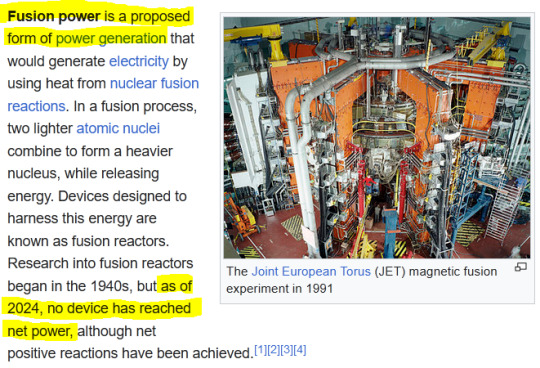
TL;DR - as of April 2024, all fusion reactors as a matter of course still consume more power to run than they are able to produce (meaning they do not reach "breakeven"). Many cutting-edge reactors also require tritium (very rare) as well as deuterium (very common) fuel.
We did not even see a fusion reaction that reached "breakeven" for power production until December of 2022. That reaction occurred at the National Ignition Facility in California, and their results just passed peer review in February of this year (2024).
Several in-progress reactors aim to improve on this, including ITER (the combined work of dozens of nations) in France, and SPARC: the new reactor under development by Mass Fusion Commonwealth Fusion Systems and M.I.T.'s Plasma Science and Fusion Center (PSFC).
Another big problem with this technology is that it involves plasma.
Plasma, as a particular song reminds us, is what the Sun is made of and The Sun Is Hot. That means plasma carries some very real 'we're-losing-structural-integrity, the-warp-core-is-breaching' risks, and we must jump through all kinds of hoops to work with it.
Why are we shoving the Sun inside a donut, again?
The most well-funded, well-researched way of smashing atoms together involves plasma and magnetic confinement fusion.
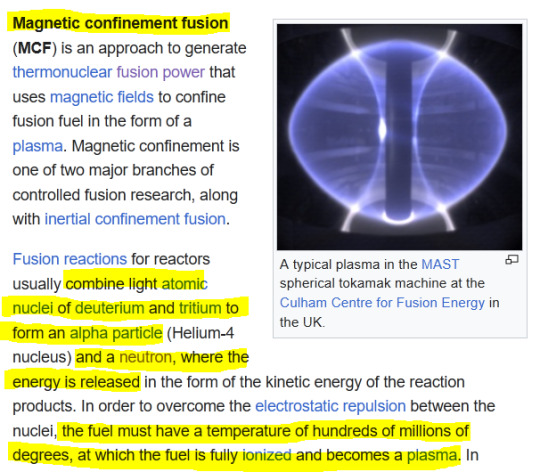
This shit is beyond cool. It may also look very familiar:
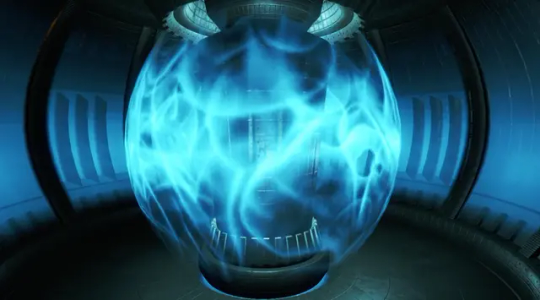
In-game, the Institute is trying to get what appears to be a spherical tokamak reactor up and running.
Bethesda's choice of reactor was no coincidence: M.I.T. operated the Alcator C-Mod, a spherical tokamak, while Fallout 4 was under development - but that reactor could not achieve "breakeven" IRL, and per Shaun's in-game dialogue, the fictional Alcator C-Mod couldn't either. (Weird given the miniaturized fusion devices everywhere in-universe, but okay, Shaun.)
However, M.I.T. stopped operating that reactor in 2016, a year after Fallout 4's release. SPARC, their planned replacement reactor actually has the sort of power potential we see in-game - and they aim to bring fusion power to market in this decade.
M.I.T., right now, in real life, is doing exactly what you're asked to help the Institute do in-game: build a fusion reactor that surpasses "breakeven."
What the hell is a tokamak and why does it look like half of a Star Trek warp core?
Your typical tokamak reactor is a great big donut-shaped vacuum chamber (the torus), traditionally surrounded by AT LEAST three sets of electromagnets (sometimes many more). M.I.T.'s design for the new SPARC reactor is a bit different, but let's start with the basics.

Why so many magnets?
Because plasma, being Literal Sun Matter, cannot come into contact with the torus containment walls or it will instantly burn through. (This happened in France in 1975. Following initial "well, fuck"s and a couple years' repairs, the logical next step was to publish a paper about it.)
The magnetic fields work to heat the plasma and provide current drive (keep electrons moving in a consistent direction through the plasma and around the torus), while also keeping it from touching anything, preventing a "warp core breach." I'll take a stab at explaining it but the Department of Energy probably does it better.
Meet the magnets:
Toroidal field magnets (blue, above): These enormous D-shaped magnets wrap around and through the torus, conducting an electrical current. This creates a magnetic field that keeps plasma from drifting horizontally into the containment walls.
Central solenoid (green, above): Inside the "donut hole" sits a massive, stacked electromagnet that generates enough electromagnetic force to launch two space shuttles at once. This heats the fuel to about one hundred million degrees Celsius so that it reaches plasma state, and helps "drive" the plasma current around the torus. (Radiofrequency or neutral beam injection heating/drive may be used as well for reactor prototypes aiming for power generation, because current drive from just the solenoid isn’t practical for continuous operation.) The central solenoid also creates another magnetic field called the "poloidal field," which "loops" around the plasma like a collar to prevent it from drifting vertically into the walls. The strongest central solenoid in existence was made for the ITER reactor...by General Atomics.
Outer poloidal field magnets (grey, above): A third set of electromagnets "stacks" up the outside of the torus, and helps maintain and adjust the poloidal field.
Together these three sets of magnets force the plasma to "float" inside the torus, shape it, and provide current drive. The stronger the magnetic field, the higher the reactor's power output.
Okay, and then what?
Given sufficient heat and drive/stability, the plasma fuel mixture undergoes fusion.
Neutrons released during fusion have plenty of kinetic energy (the kind of energy a kickball has midair before it hits you in the face), but no electric charge.
Since magnetic fields only affect negatively or positively charged particles, neutrons completely ignore the fields, sailing straight through and slamming into a "blanket" of metal coating the donut's insides. Neutrons passing into the 'blanket" lose their kinetic energy, which is converted to heat and absorbed by the "blanket." (ITER's "blanket" involves a lot of beryllium, which...behaves a bit differently IRL than it does in-game.)
Heat captured by the "blanket" is then used to generate power. For instance, a water cooling system can bleed heat from the "blanket," regulating temperature and creating superheated highly-pressurized steam to run turbine generators.
I notice you described a "typical" tokamak above -what's the atypical option?
Check out SPARC.
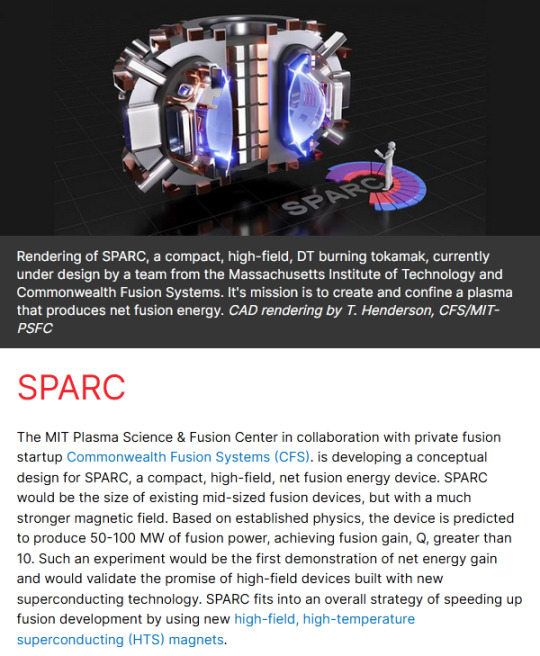
Its huge design departure is that it uses new high-temperature superconducing magnets (most existing types have to be cooled to vacuum-of-space temperatures using something like a liquid helium system to achieve superconductivity, which is a huge power drain) to create a monstrous magnetic field - and its size is tiny in comparison to its projected power output.
Neat. So why did you refer to plasma as a problem?
Well...between the heat and the neutrons, the "blanket," the "first wall" and all plasma-facing surfaces inside the torus take one hell of a beating:

"Neutron degradation of wall surfaces-" "Energy is released in the form of the kinetic energy of the reaction products-" In practical terms, that just means countless neutrons are doing THIS:

...but to the containment wall and other surfaces inside the torus, instead of to Batshuayi's face. And so:

Basically, this stuff breaks fast enough - and the only materials that don't break quickly are rare enough - to create a real barrier to commercial use.
And THIS is one of the problems they're working on solving in M.I.T.'s basement.
Now we can talk about the Vault. FINALLY.
M.I.T. is home to the Center for Science and Technology with Accelerators and Radiation (CSTAR). CSTAR's splash page announces:

Linear plasma devices? You mean like -
No, not like plasma rifles. Instead of weapons, we're talking about tools being used to solve the "plasma fucking destroys everything it touches" problem.
How does CSTAR do this? They've got CLASS. ...No, really:

This field is called plasma-surface interaction science, and if you want a really long but very informative read on how CSTAR's work helps move it forward, check this out. It involves the DIONISOS Linear Plasma Device - a "let's shoot it with plasma and see what happens" tool.
CSTAR also works to better undertstand how materials handle radiation damage, and how they behave after becoming irradiated.
And to handle this sort of work, one needs a...

The Vault Laboratory for Nuclear Science "combines high-intensity particle sources, precision particle detection, and a heavily shielded experimental area to create a facility for nuclear research in high-radiation environments." It contains, among other things:
the DT Neutron Generator, which is used in a variety of experiments, including radiation detector development (pretty damned important) and characterization, fast neutron imaging, and material activation (stuff becoming radioactive).
the DANTE Tandem Accelerator, which was "originally designed to produce high neutron yields for use in cancer therapy research."
And that is what's actually going on in M.I.T.'s basement: truth is cooler than fiction.
The takeaways:
Yes, M.I.T. really is building a revolutionary fusion reactor with parts from Mass Fusion Commonwealth Fusion Systems.
Yes, there really is a secure underground facility where incredibly advanced research related to nuclear fusion, radiation detection, irradiated materials, and degradation of materials due to radiation exposure takes place.
Yes, I really would spend eight hours researching nuclear physics instead of doing more dishes. Shoutout to @twosides--samecoin for tolerating my absurd hyperfocus on researching this.
Thanks for coming to my TED talk on what M.I.T. is really doing in its basement.
Tune in next time for M.I.T.'s Media Laboratory, and how it is related to real-world power armor, plus: the relationship between Langley, P.A.M.'s IRL cousin, and Vault 101.
** (Fallout is wildly inconsistent re: how widespread fusion is in-game and when it was developed. I mean we're talking a two-decade spread of inconsistency! And somehow the technology - first available to the military - was then miniaturized and made available to the general public before becoming widespread for commercial power generation? And somehow we both do and don't have impossible cold fusion in game? It's a mess. I reject this reality and replace it with a fish, hence this post. Also, I hate fission batteries. don't talk to me about fission batteries, "fission batteries" are small fission reactors but they are definitely not "battery sized" - the "fission batteries" in-universe are so miniaturized that they are more likely another kind of atomic battery like a radioisotope thermoelectric generator and those are subject to a law of diminishing returns as the fuel decays/not producing a reasonably useful power output after over 200 years due to the isotopes normally used/can be VERY dangerous if the shielding is breached or removed, and - you know what, that's also a whole different post.)
#actual insanity#fallout#fallout 4#why am I like this#nuclear fusion#physics#institute#fallout institute#the institute#worldbuilding#meta#oneifbyland#wasteland survival guide
41 notes
·
View notes
Text
Hot take: Any and all efforts asking companies to refuse to adopt automation/AI systems that would save costs for the sake of human jobs (fairly understandable urge on the face of it) should be funnelled into asking them to just. Give you money. Or more properly, to support UBI funds. This is because you are essentially asking for the exact same monetary sacrifice/outcome (suffer reduced profits in order to benefit the worker population) without the added side-effect of engaging in weird anti-tech politics that hurts people who work in engineering fields and the cause of developing generally more productive production chains that could be enhanced by automation.
"But, that's pointless, there's no way we can convince companies to just give away free money!" You're right, that's capitalism baby, and they will refuse to listen to your complaints about automation/AI for the same reason. It's because companies operate under a profit motive by definition, and so you should actually be lobbying for government regulation, i.e. an automation/surplus tax towards a UBI. This avoids the shortfall of the "AI is the devil" approach while also having the advantage of actually being feasibly useful at getting positive outcomes for the working class (lobbying corporations to not adopt cost-cutting measures will not do this, at least not in the long term).
#not-terezi-speaks#ai#the solution to this problem does not lie in technophobia or boycotts#it lies in political organizing#please stop wasting your efforts on pointless#harmful campaigns#because you are scared and angry that machines can make pretty pictures now
169 notes
·
View notes